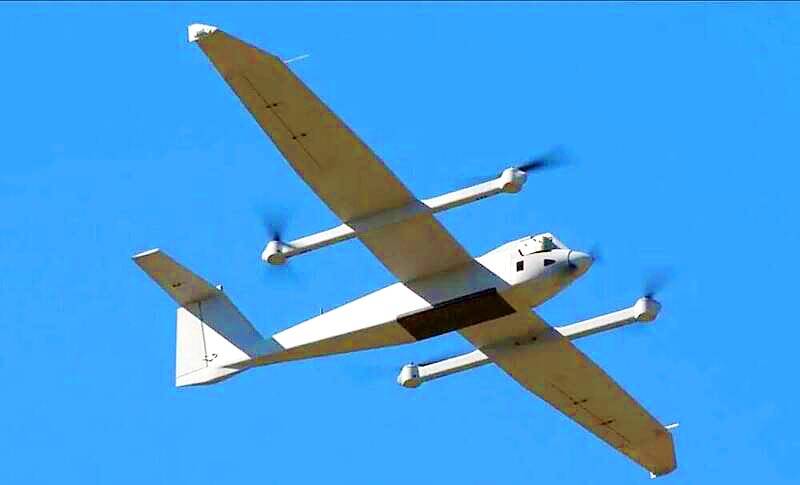The US is considering providing the navy with Jump 20 uncrewed aerial vehicles to strengthen its mid to long-range reconnaissance capabilities and support its development of a new-generation reconnaissance drone, a source familiar with the matter said yesterday.
The US previously provided drones of the same type to the Coast Guard Administration in 2022, the source said, adding that the drones offered to the navy, although of the same kind, would have more advanced specifications.
The drone was provided as part of the US foreign military financing program, the source said.

Photo: screen grab from AeroVironment Inc’s Web site
The Jump 20 is among the first wave of drones developed under the US Future Tactical Uncrewed Aircraft System Program and has only been provided to Ukraine and Taiwan outside the US armed forces, the source said.
The US has allegedly provided Taiwan “free military assistance” per the 2023 National Defense Authorization Act, including 80,000 sets of personal equipment and 1,000 M240B machine guns, the source said.
The Ministry of National Defense has neither confirmed nor denied the reports.
The source declined to comment on what other kinds of equipment would be provided aside from the Jump 20 drone.
The Jump 20 is a fixed-wing drone with vertical takeoff and landing capabilities. It was developed by Arlington, Virginia-based AeroVironment Inc.
Chang Yen-ting (張延廷), a former deputy commander of the air force, in 2023 said that the drone can provide multisensor intelligence, and surveillance and reconnaissance capabilities.
The drone can stay airborne for more than 14 hours per mission and has a top speed of 93kph, he said, adding that its low visual and acoustic signature make it ideal for multimission operations.
Chieh Chung (揭仲), an associate research fellow at the National Policy Foundation in Taipei, in 2023 said that the drone would indirectly improve Taiwan’s capability to survey its surrounding waters, which would help the nation counter “gray zone” threats by China.

Beijing could eventually see a full amphibious invasion of Taiwan as the only "prudent" way to bring about unification, the US Department of Defense said in a newly released annual report to Congress. The Pentagon's "Annual Report to Congress: Military and Security Developments Involving the People's Republic of China 2025," was in many ways similar to last year’s report but reorganized the analysis of the options China has to take over Taiwan. Generally, according to the report, Chinese leaders view the People's Liberation Army's (PLA) capabilities for a Taiwan campaign as improving, but they remain uncertain about its readiness to successfully seize

HORROR STORIES: One victim recounted not realizing they had been stabbed and seeing people bleeding, while another recalled breaking down in tears after fleeing A man on Friday died after he tried to fight the knife-wielding suspect who went on a stabbing spree near two of Taipei’s busiest metro stations, Taipei Mayor Chiang Wan-an (蔣萬安) said. The 57-year-old man, identified by his family name, Yu (余), encountered the suspect at Exit M7 of Taipei Main Station and immediately tried to stop him, but was fatally wounded and later died, Chiang said, calling the incident “heartbreaking.” Yu’s family would receive at least NT$5 million (US$158,584) in compensation through the Taipei Rapid Transit Corp’s (TRTC) insurance coverage, he said after convening an emergency security response meeting yesterday morning. National

Taiwan is getting a day off on Christmas for the first time in 25 years. The change comes after opposition parties passed a law earlier this year to add or restore five public holidays, including Constitution Day, which falls on today, Dec. 25. The day marks the 1947 adoption of the constitution of the Republic of China, as the government in Taipei is formally known. Back then the Chinese Nationalist Party (KMT) governed China from Nanjing. When the KMT, now an opposition party in Taiwan, passed the legislation on holidays, it said that they would help “commemorate the history of national development.” That

Taiwan has overtaken South Korea this year in per capita income for the first time in 23 years, IMF data showed. Per capita income is a nation’s GDP divided by the total population, used to compare average wealth levels across countries. Taiwan also beat Japan this year on per capita income, after surpassing it for the first time last year, US magazine Newsweek reported yesterday. Across Asia, Taiwan ranked fourth for per capita income at US$37,827 this year due to sustained economic growth, the report said. In the top three spots were Singapore, Macau and Hong Kong, it said. South